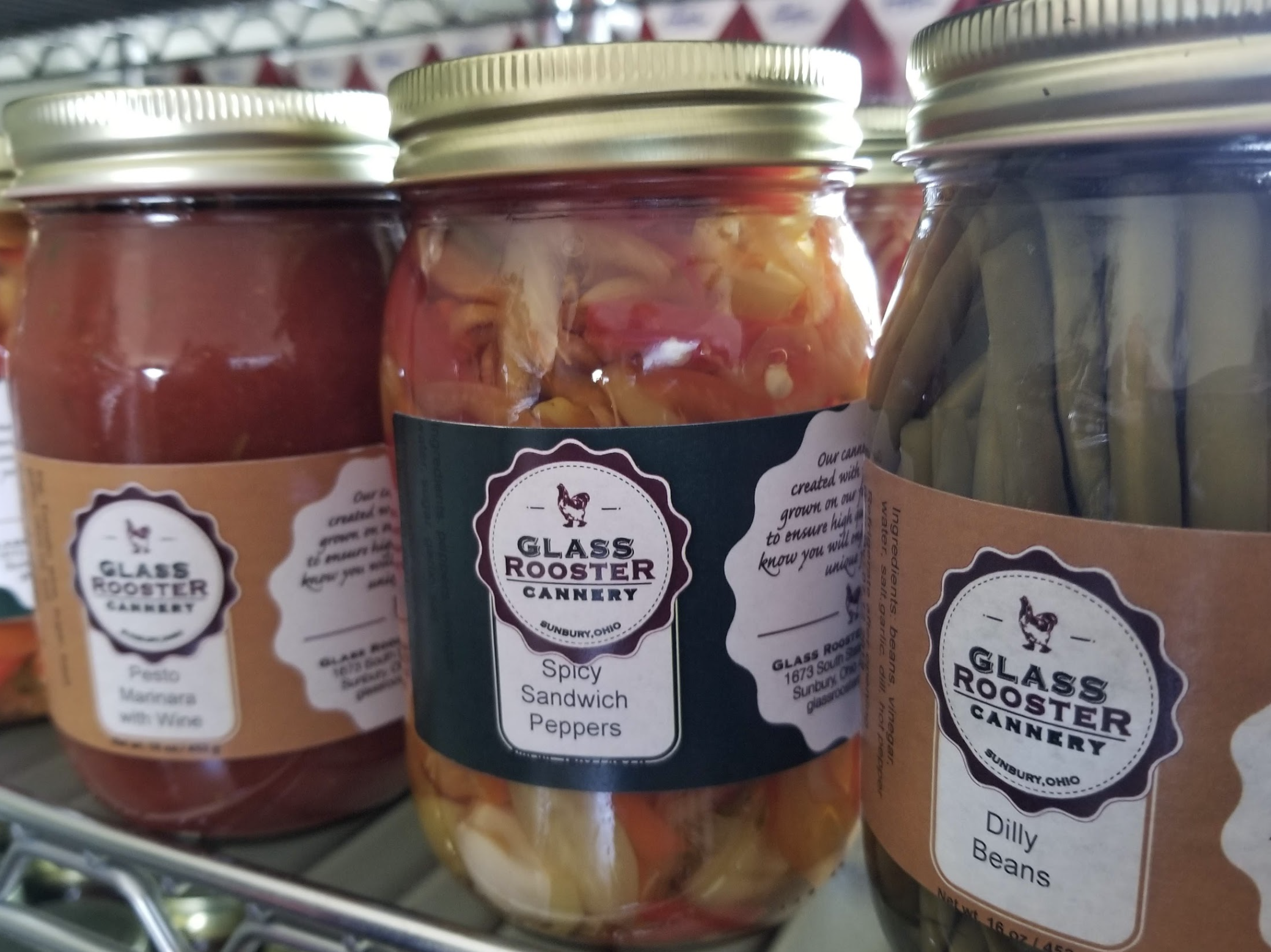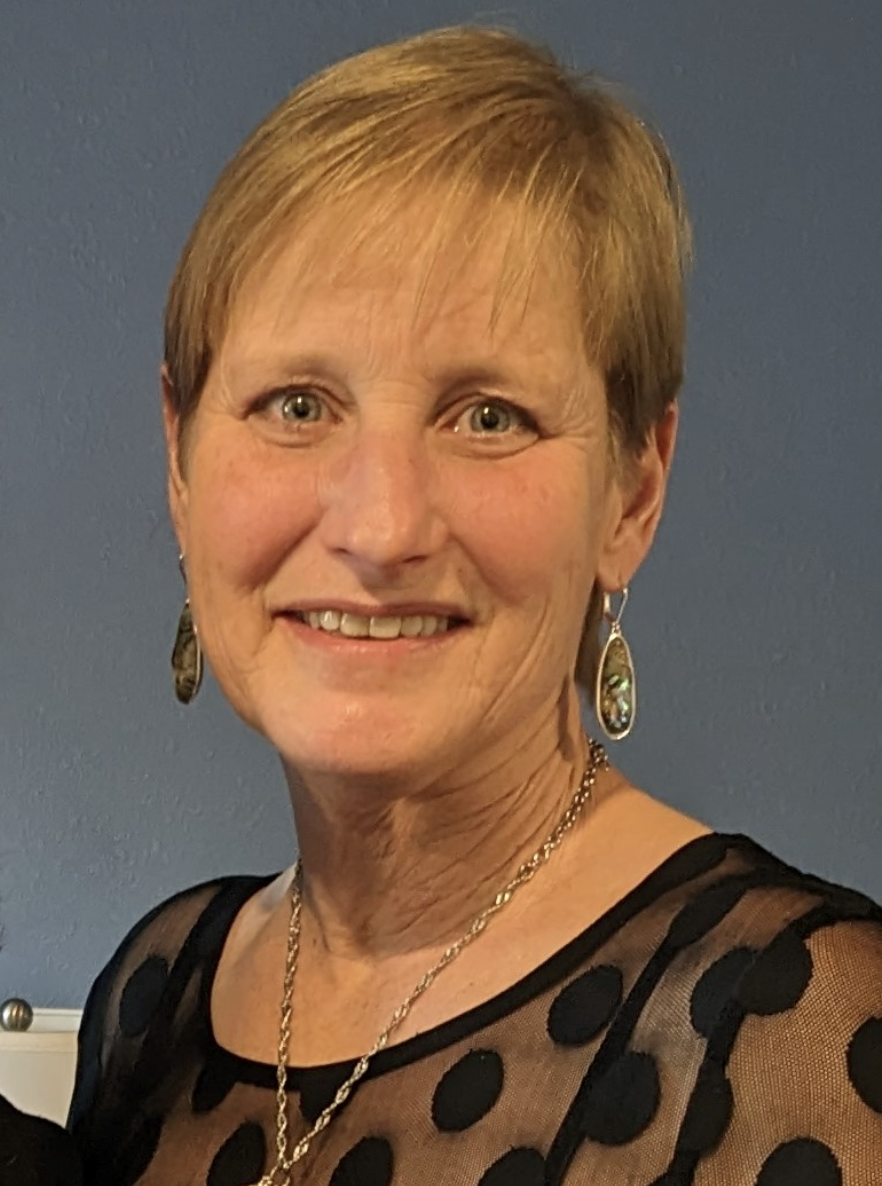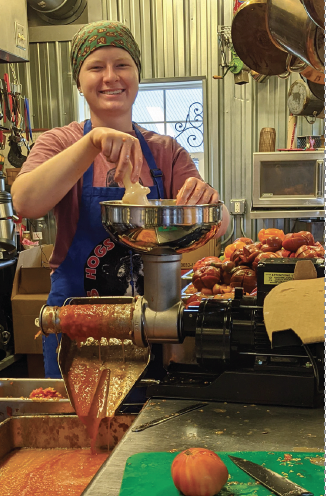
The year before we applied for the first SARE grant, a farmer approached us with a whole bunch of hot peppers he didn’t know what to do with. As a licensed cannery, we had a sauce recipe to process these peppers that was approved already. That got us thinking about the amount of waste that farms have. So, the next season we applied for a SARE grant to purchase a steam jacket kettle. ... It allowed us to make a whole lot of sauce at one time. And so we reached out to a few farmers. ... We saved, well, after 30,000 pounds of produce I quit counting.”
—Jeanine Seabrook, Farmer/Rancher Grantee
A new steam jacket kettle and processing/cooling system contributed to Glass Rooster Cannery’s ability to improve production efficiency, reduce waste, and provide value-added, shelf-stable products for local farmers, increasing farmers’ extended season revenues.

Region: North Central
State: Ohio
Grant Type: Farmer/Rancher
Grant: FNC16-1056
SARE POST-PROJECT EVALUATION IMPACT MODEL
This evaluation impact model is specific to this SARE-funded project.
Sustainability Impacts
The project grantees and stakeholders contributed to the following sustainability impacts:
- Economic sustainability impacts
- Production efficiency impacts
- Social sustainability impacts
Grantee Indicators
(Farmer/Rancher)
Project grantees (defined above) achieved sustainability impacts by engaging with the following indicators through involvement with project activities:
- Increased knowledge/skills
- Increased capacity/motivation
- Increased engagement
- Practice change
- Career growth
Stakeholder Indicators
(Partner Farmers, Student, the Public)
Project stakeholders (defined above) achieved sustainability impacts by engaging with the following indicators through involvement with project activities:
- Increased knowledge/skills
- Increased engagement
- Career growth
The Success Story

Jeanine (Jeannie) Seabrook, experienced farmer, founder/owner of Ohio-based Glass Rooster Cannery (GRC), and two-time SARE grantee, partnered with local farmers to keep their seconds and between-market produce out of the compost pile and generate extended season income for farmers. Seabrook first utilized SARE funding to purchase a 40-gallon steam jacket kettle to improve her ability to can her own produce more efficiently and partner with local farmers to process produce beyond the scope of her own business. The new equipment enabled GRC to partner with eight local farmers and process more than 12,000 lbs. of produce in the first season, resulting in approximately 8,000 jars of product and providing an additional income stream for both the cannery and the partner farmers. The project was so successful that farmer interest outweighed the cannery’s ability to process produce fast enough before the risk of spoilage, and Seabrook was subsequently only able to take on one partner farmer at a time. To scale up production, Seabrook applied for a second SARE grant to purchase a larger commercial food processor and cooling system and fund a part-time production assistant. In the 2021 season, Seabrook successfully processed more than 30,000 lbs. of produce. Beyond the grant term, Seabrook has maintained strong, ongoing partnerships with local farmers. Additionally, since founding the cannery in 2010 and getting licensed in 2014 as the business grew, Seabrook’s vision for a sustainable farm and cannery has expanded to include an agritourism business and classes at the cannery that restore intergenerational knowledge and skills for young adults and families about processing food and creating healthy meals.
A Second SARE Grant Further Scaled Up Production, Benefitting More Partner Farmers and Improving Product Quality
When people brought their produce in, I had to get it processed within 24 hours because I had nowhere to store it, and I could only take on one farmer at a time. ... Farmer two was not going to be bringing his stuff until I got farmer one's stuff done. So, when we asked for [Second SARE grant] funding to help us buy the cooler, that allowed us to take on two or three farmers at a time. That really improved our productivity and the quality of the product.”
—Jeanine Seabrook, Farmer/Rancher Grantee
Grantee (Farmer/Rancher) Highlights
Throughout the grant period, Seabrook acquired business acumen as she expanded cannery services, scaled up the business, and strengthened local farmer-to-farmer partnerships. Over the course of the two SARE-funded projects, Seabrook increased her marketing knowledge in terms of her products and online services and learned more about the canning supplies she needs to best store her value-added products and maintain scaled-up production. With the addition of a part-time employee, partially funded through the second SAREgrant and then funded by her business beyond the grant period, Seabrook developed supervision and delegation skills. Due to being awarded and successfully implementing SARE grants, Seabrook felt empowered to apply for more grants and in April 2023, she received a Rural Energy for America Program grant through the United States Department of Agriculture to install solar panels on her barn.
Other Stakeholder (Partner Farmers, Students, The Public) Highlights

Cameron is processing tomatoes that were unsold at the farmer’s market. We are able to process about 350 pounds of tomatoes in one batch. Credit: Jeanine Seabrook
As a result of involvement in SARE grant activities, partner farmers expanded their marketing knowledge and skills and learned the importance of having their farm logos on products to increase brand recognition. This was done with a “dual labeling” system, featuring both the farmer logo and the GRC logo (the GRC logo ensured legal compliance as the product was processed at a licensed cannery). The labeling also gave consumers more information about the product and its local ingredients. After some trial and error, and with the guidance of Seabrook and her GRC team, partner farmers learned the ideal timing to deliver goods for canning without the risk of spoilage in transport. Most significantly, through canning their produce, farmers were able to sell shelf-stable goods outside of harvest season and generate income year-round. Seabrook sold thousands of her own products along with the canned goods of local farmers at her on-farm storefront and partner farmers reported they successfully sold their products through their established channels at local farmers markets. Seabrook affirmed that this additional income stream allowed her and partner farmers the financial padding they needed to be innovative and creative, which promoted business growth. For example, one partner farmer had produced more cucumbers than they could sell at market. In collaboration with Seabrook, pickling and relishing became a viable option. This farmer went on to sell the canned goods in local markets and was amazed at the positive response by consumers (more detail on this story here). Seabrook continues to collaborate with several of the farmers she originally partnered with during her SARE grant. Additional stakeholders that continue to benefit from Seabrook’s knowledge and skillset include students and the wider public who attend classes and events at the cannery. The cannery’s agrotourism business provides on-site “farm to fork” meals, host weddings, and rents out a guest house. Through marketing and networking via the GRC website and social media, Seabrook has increased the reach of her services beyond her local community to people from other states and international students. Further, she has shared what she learned from her SARE-funded projects with producers and the wider sustainable agricultural community through presentations at conferences and the Ohio Ecological Food and Farm Association networks. Central State University Extension has been another important collaborator by referring new farmers to partner with GRC. Seabrook regularly receives invitations from agricultural organizations and local press to tell her success story, demonstrating the broad reach of her ongoing efforts at the cannery.
The Income Generated From Value-Added Goods Provides A Much-Needed Financial Cushion in the Farming Business and Enables Innovation and Creativity
Each year this farmer brings me their apples and we make apple butter and they take it back and sell it for about 50% profit over what we charge them. That has allowed a single parent family to have additional income through the winter ... not just the summer markets, the fall markets. ... It's not going to be the thing for either of us that makes or breaks our business, but it's the thing that pads us enough to feel free to extend ourselves in some creative area and ... that's important as a business owner in order to grow”
—Jeanine Seabrook, Farmer/Rancher Grantee
Sustainability Impacts
SARE funding contributed to increased production efficiency by reducing farm waste (i.e., seconds or between market produce) and improving both the quality and quantity of canned goods. As a result of both the steam jacket kettle and the enhanced storage, processing, and cooling system, Seabrook far surpassed her production goals. The enhanced storage and cooling system enabled expediency and Seabrook now has the capacity to take in produce from two to three farmers in one go, rather than being limited to working with one farmer at a time. The SARE-funded equipment improved the canned products’ quality and consistency and continues to be a key part of the cannery production system. In terms of economic sustainability, GRC employed a business model that enabled the cannery to make a profit by selling canned goods back to partner farmers while leaving a considerable markup margin for farmers to also profit at market. Additionally, because canned products are shelf-stable, they are saleable year around and provide farmers with income streams during non-harvest times. Seabrook also advanced social sustainability through farm-based classes that offer “what grandma used to teach,” making food processing knowledge and skills accessible to a new generation of young people and building a sense of community for people outside of GRC’s immediate rural area (including people from other states and international students). Seabrook noted that many young people are not exposed to food processing know-how like they used to be through intergenerational learning. In response, GRC is filling this gap by teaching classes about canning local produce at home for year-round enjoyment and offering courses on making healthy meals from scratch with fresh farm ingredients.
I don't think students come in thinking, 'Oh, now I'm going to have a skill I can take home and make these empanadas for my family.' I think what happens is they want an experience and they come in and they go 'Oh my gosh! This is so much easier than I thought!' I'm pulling in people because they want the community they feel with people here.”
—Jeanine Seabrook, Farmer/Rancher Grantee
Building Community and Transmitting "What Grandma Used to Teach" To Younger Generations

